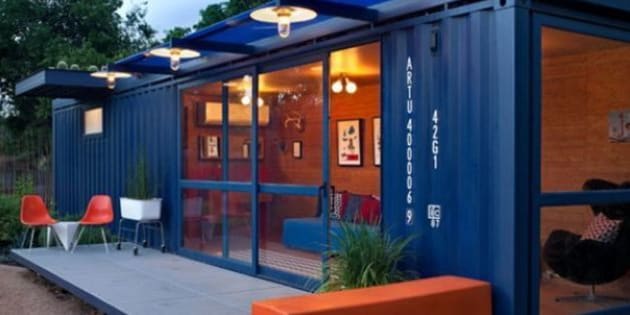
RentSeeker.ca
Tiny Homes
How much space do you really need to live comfortably? For those living in tiny homes, the answer is not much! Typically occupying less than 400 square feet, tiny homes feature many of the amenities of a traditional house, in a fraction of the space and at a fraction of the cost. Lack of physical space and crammed living conditions are a natural downside, making it tough for most people to feel comfortable in a tiny home. On the other hand, this option is becoming an increasingly popular concept in dense cities, and living with less also greatly reduces energy usage, cost of living and environmental impact, all while giving the term downsizing a whole new meaning. And, tiny homes can also be "quite the party pad" as this tiny house in Salt Spring, B.C. shows.
Essentially, people are taking metal shipping containers and incorporating them as the structural components of their home. Ranging from single containers to multi level abodes consisting of several containers engineered to fit together, the results can be simply stunning. Benefits of using shipping containers to build homes include affordability, durability, and convenience, along with a significant reduction of materials used during the building process. Another important benefit is the number of environmentally-friendly features that you can incorporate into these homes such as solar panels and hi-tech rainwater harvesting systems. Less expensive options are available, but for those who can afford it, these homes can be both eco-friendly and cosmetically impressive, offering impressive levels of comfort and style for those living off the grid.
Of all the options we researched and explored, modular / prefabricated homes, or manufactured homes are the most common. In fact, many large real estate companies like CAPREIT and Realstar offer these options. These homes can be completely prefabricated at the manufacturing factory or shipped out in sections. Since the early 1900s people have benefited from modular homes, which reduce many of the construction costs by eliminating man-hours and greatly reducing the amount of wasted materials that normally occur during the building of a home. Whether you prefer to buy a kit and build your home yourself, modular and prefabricated homes provide affordable and eco-friendly housing options.
Vehicle Homes
Using a vehicle as a home isn't as absurd as it used to be, and we aren't referring to mobile homes. There are working professionals who are choosing to live in small, modified vehicles for extended periods of time, often citing freedom and cost savings as the top benefits. Like the case of the Google employee living in the parking lot, early this year the story of Blue Jays prospect Daniel Norris living in a van proves that home is where the heart -- or steering wheel is. If you can live without the convenience of a proper bathroom or shower, you can save a ton of money while being able to move your home at your will, without worrying about finding the next trailer park.
Pallet Homes
Wooden pallets are an essential part of the modern shipping and transportation industry and as a result, are in abundance all over the globe. In numerous facilities, pallets build up in excess and become a costly nuisance to eliminate, making them extremely affordable to acquire in large quantities. Pallets can be recycled and used as the structural components in a home, paving the way for affordable, low-income or temporary housing options where traditional building materials are scarce or expensive. With some creativity, pallet homes can come pretty awesome
Tree Houses
Hardly a new concept, tree houses have existed in various civilizations for hundreds of years. Today, they can range from modest living accommodations to awe inspiring hotels, rich in architectural sophistication and style. It's not cheap or easy to maintain such a property, and as a result, these homes are not a very cost effective option for typical families. Expect them to be commonly used as hotels in tropical areas where the forest canopy is full of flora and fauna, offering incredible opportunities to experience nature up close. Although they can be extremely eco-friendly, tree house hotels are some of the most luxurious alternative housing options, costing guests hundreds of dollars per night.
You don't need to live in a tree or move into your car to find the perfect place for your needs and budget. Technological evolution will provide new options for improved building materials and greater opportunities for affordable, environmentally friendly living spaces. In the meantime, most will agree that these alternative homes aren't suitable to live in on a daily basis and for those who prefer traditional living spaces, don't worry, there are still plenty of options. From houses, condos, to apartments and everything in between, making your living space a home is a matter of attitude. As the Dalai Lama once said "Home is where you feel at home..."
ALSO ON HUFFPOST:



No comments:
Post a Comment